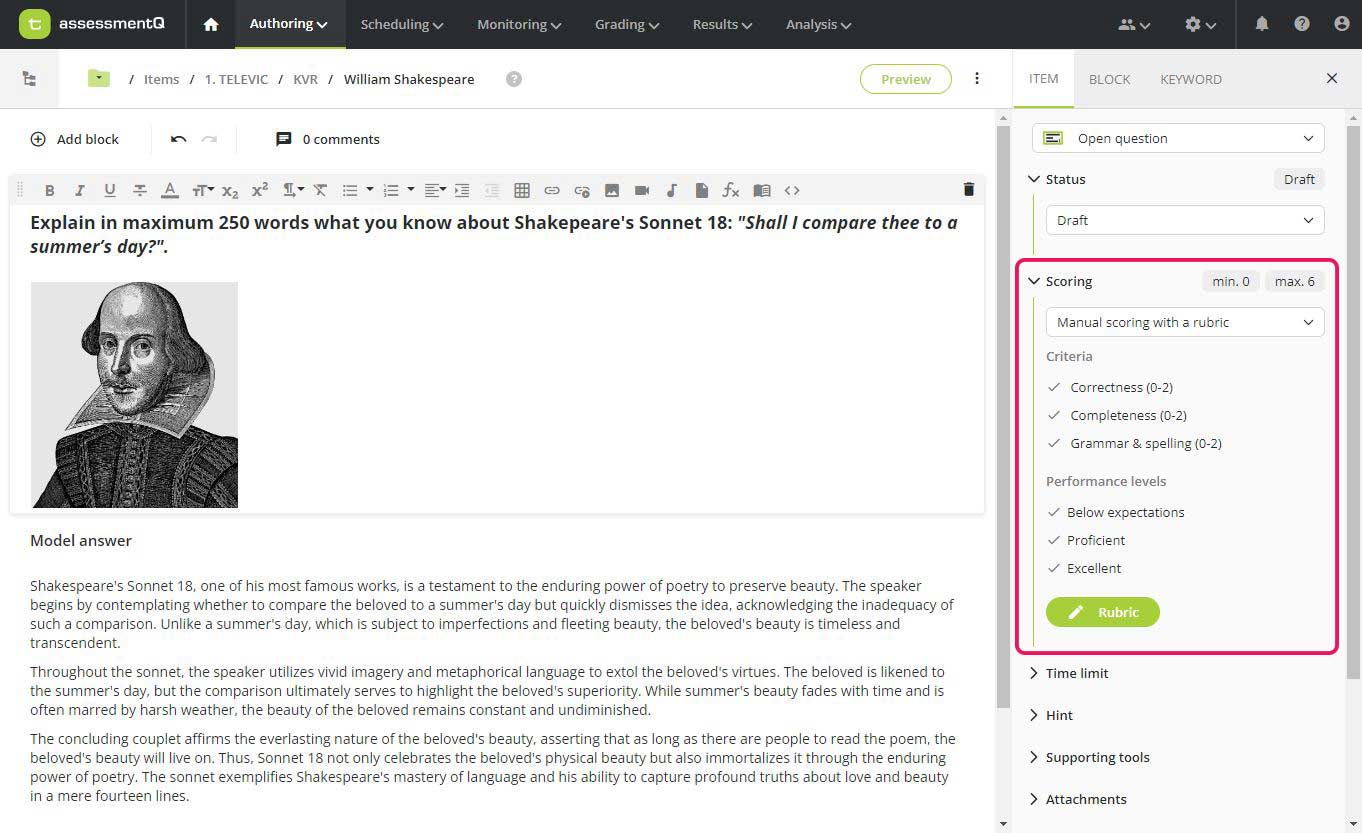
How to use rubrics when scoring a digital exam?
How do you ensure maximum consistency and fairness when grading an exam? It’s a long-standing yet relevant question, in particular when an exam makes heavy use of open questions, or when the exam is mostly oral. Is there a way to guarantee maximum objectivity and transparency to candidates? Enter ‘rubrics’, the clever framework for consistency in the world of (digital) exams.
What are rubrics?
You could define a rubric as a blueprint for grading. A rubric is a structured scoring guide that outlines the criteria for evaluating a candidate’s or student’s performance.
Whether it’s an essay, a case study, or an oral assignment, rubrics break down the grading into specific components, making it clear for graders to understand what’s expected. And even for candidates, if you inform them upfront about the rubric you will use.
Why use rubrics?
Consistency
Ever wondered why two different graders might give the same response a different score? Because grading can be subjective. Rubrics provide an objective framework for evaluation, ensuring that all graders assess students’ work using the same criteria. This consistency makes the grading process more objective and more reliable.
Efficiency
Time is precious. Rubrics help streamline the grading process by providing a clear blueprint for the graders. Instead of deciphering each response from scratch, evaluators can refer to the rubric to quickly evaluate the exam questions. This not only saves time but also ensures that grading is done efficiently without compromising quality.
Transparency
If you communicate the rubrics to the candidates, you eliminate the guesswork by clearly defining expectations. They know precisely what aspects of their work will be evaluated and how they’ll be graded. No more ambiguity, no more surprises.
The grader not only gives a score per rubric, he/she can also add qualitative feedback to further increase the transparency.
Types of rubrics: analytical vs. holistic
In the world of grading, graders often distinguish two types of rubrics: ‘analytical’ and ‘holistic’.
Analytical scoring
Analytical scoring, also known as ‘checklist scale’, involves breaking down a task into specific actions, which are listed in advance. The checklists used can be either binary (yes/no) or adopt a rating scale (1-7) to evaluate the quality of a candidate’s actions.
While these binary checklists were initially believed to provide objective assessments, studies have questioned their reliability, especially when expert examiners are involved.
Holistic scoring
Holistic scoring, also known as ‘global rating scale’, rates the overall performance rather than individual actions. This method is particularly useful for assessing skills where quality matters as much as completion. For instance, when grading communication skills, holistic scales are better suited for evaluating empathy, judgment, and other complex skills.
Some examples
Essay writing
Let’s assume you’re teaching a literature course, and it’s time for the final exam. Students are tasked with analyzing a novel and crafting an essay. Your rubrics might include criteria such as
- thesis clarity,
- use of evidence,
- depth of analysis,
- language & spelling.
Each of these criteria can be described in detail, so that all graders know perfectly what needs to be considered.
With this rubric in hand, students know exactly what you’re looking for in their essays, and you can evaluate their responses more consistently and objectively.
Maths
In a mathematics test, candidates are presented with a series of problems to solve. In this example, your rubrics might assess:
- problem-solving skills,
- accuracy of the calculations,
- clarity of the explanation.
By using a rubric, you can provide targeted feedback to help candidates improve their skills while at the same time ensuring fairness in grading.
So, what are the main benefits of using rubrics?
Fairness
Rubrics introduce extra objectivity by providing a standardized set of criteria for assessment. Regardless of who’s the grader, all exam takers are evaluated based on the same benchmarks, ensuring fairness and equity in the grading process.
Feedback
Constructive feedback is essential for people to learn and grow. Rubrics not only help candidates understand how they’re being evaluated but also provide clear guidance on areas for improvement.
By highlighting specific strengths and weaknesses, rubrics empower students to reflect on their performance and take actionable steps to enhance their skills. Sub scores per criterion provide much more detailed feedback than a simple “note”.
Engagement
When candidates know exactly what’s expected of them, they’re more likely to engage with the subject in a meaningful way. Rubrics encourage candidates to focus on key concepts and skills during their preparation, leading to deeper learning and better performance.
Conclusion
In conclusion, rubrics are indispensable tools for ‘objectivising’ the exam grading process. By providing clarity, consistency, and efficiency in grading, rubrics ensure fairness for candidates while also easing the burden for graders.
If you haven’t started using rubrics yet, this might just be the moment to do so. Know that sophisticated digital exam platforms, like assessmentQ, have everything onboard to give you a head start.




